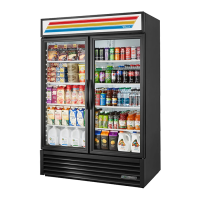99
COMPLAINT
Compressor will not
start - no hum
Compressor will not
start - hums but trips
on overload
protector
Compressor starts, but
does not switch off of
start winding
Compressor starts and
runs, but short cycles
on overload protector
Unit runs OK, but
short cycles on
POSSIBLE CAUSE
1. Line disconnect switch open.
2. Fuse removed or blown.
3. Overload protector tripped.
4. Control stuck in open position.
5. Control off due to cold location.
6. Wiring improper or loose.
1. Improperly wired.
2. Low voltage to unit.
3. Starting capacitor defective
4. Relay failing to close.
5. Compressor motor has a winding open or shorted.
6. Internal mechanical trouble in compressor.
7. Liquid refrigerant in compressor.
1. Improperly wired.
2. Low voltage to unit.
3. Relay failing to open.
4. Run capacitor defective.
5. Excessively high discharge pressure.
6. Compressor motor has a winding open or shorted.
7. Internal mechanical trouble in compressor
(tight).
1. Additional current passing through overload
protector.
2. Low voltage to unit (or unbalanced if three
phase).
3. Overload protector defective.
4. Run capacitor defective.
5. Excessive discharge pressure.
6. Suction pressure too high.
7. Compressor too hot - return gas hot.
8. Compressor motor has a winding shorted.
1. Overload protector.
2. Thermostat.
3. High pressure cut-out due to:
a. Insufficient air.
b. Overcharge.
c. Air in system.
4. Low pressure cut-out due to:
a. Liquid line solenoid leaking.
b. Compressor valve leak.
c. Undercharge.
d. Restriction in expansion device.
REPAIR
1. Close start or disconnect switch.
2. Replace fuse.
3. Refer to electrical section.
4. Repair or replace control.
5. Relocate control.
6. Check wiring against diagram.
1. Check wiring against diagram.
2. Determine reason and correct.
3. Determine reason and replace.
4. Determine reason and correct, replace if
necessary.
5. Replace compressor.
6. Replace compressor.
7. Add crankcase heater and/or accumulator.
1. Check wiring against diagram.
2. Determine reason and correct.
3. Determine reason and correct, replace if
necessary.
4. Determine reason and replace.
5. Check discharge shut-off valve, possible over-
c h a rge, or insufficient cooling on condenser.
6. Replace compressor.
7. Replace compressor.
1. Check wiring diagram. Check for added fan
motors, pumps, etc., connected to wrong side
of protector.
2. Determine reason and correct.
3. Check current, replace protector.
4. Determine reason and replace.
5. Check ventilation, restrictions in cooling medi-
um, restrictions in refrigeration system.
6. Check for possibility of misapplication. Use
stronger unit.
7. Check refrigerant charge (fix leak), add if
necessary.
8. Replace compressor.
1. See D. above.
2. Differential set too close - widen.
3a. Check air or water supply to condenser -
correct.
3b. Reduce refrigerant charge.
3c. Purge.
4a. Replace.
4b. Replace.
4c. Fix leak, add refrigerant.
4d. Replace device.
WARNING: ELECTRICAL POWER MUST BE DISCONNECTED WHEN TERMINAL PROTECTIVE COVER NOT
IN PLACE TO PROTECTAGAINST ELECTROCUTION OR VENTED TERMINAL.
A
B
C
D
E
CFC & REFRIGERATION BASICS
Trouble Shooting and Service Chart

